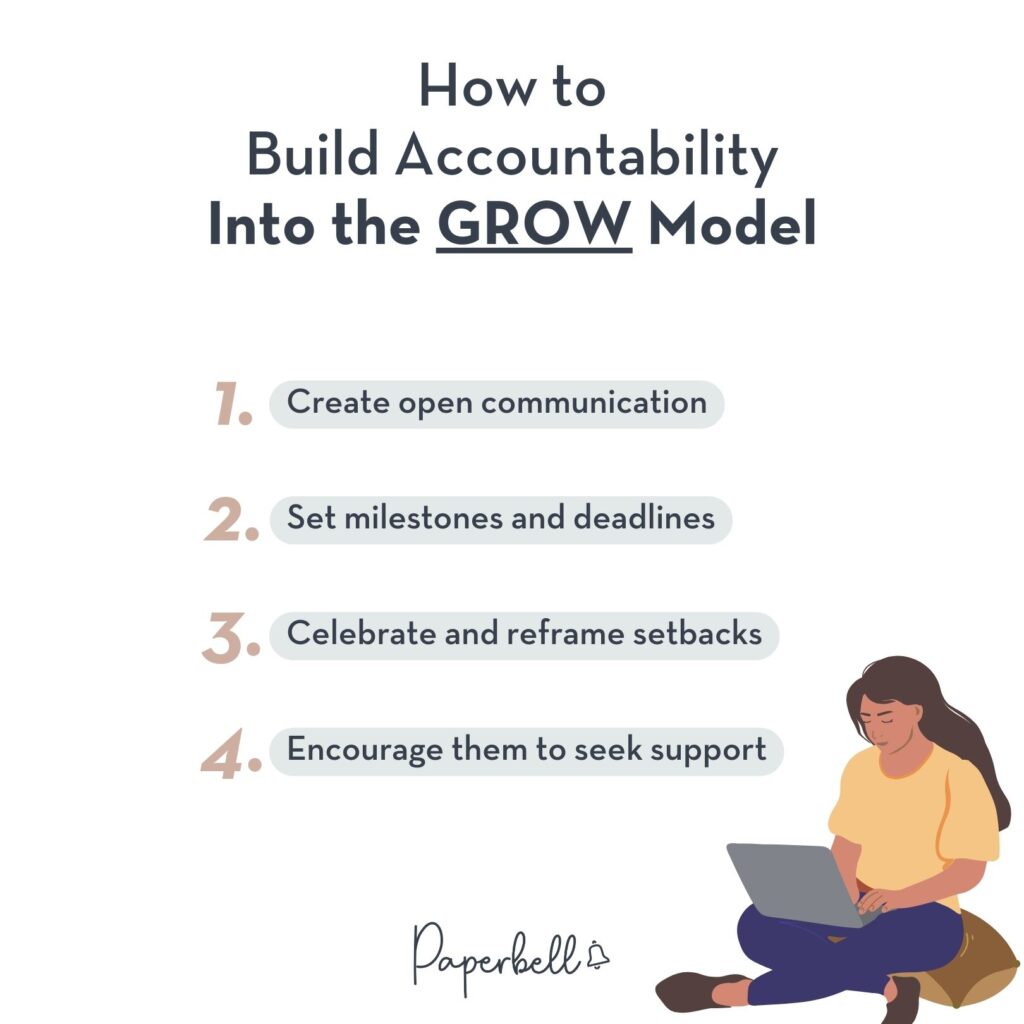Are you looking for ways to support your coaching clients on a deeper level?
One proven way is to use a structured framework that guides them toward meaningful change. The GROW model is one of the most widely recognized approaches in coaching, known for helping clients clarify their goals and take actionable steps forward.
In this article, you’ll learn:
- What the GROW coaching model is and where it came from
- The four key stages of the framework
- How to integrate accountability and progress tracking into your coaching process
GROW Model: The Most Widely Used Coaching Framework
The GROW model is one of the best-known coaching frameworks, created in the 1980s by Sir John Whitmore and his colleagues at Performance Consultants International. It has since become a cornerstone of coaching worldwide.
GROW stands for:
- Goal
- Reality
- Options (or Obstacles)
- Will (or Way Forward)
Leading clients through these stages helps them define clear goals, explore their current situation, and identify multiple paths forward before committing to an action plan. It’s the perfect balance between keeping the client focused yet open to different possibilities.
This process encourages both accountability and creativity. It makes clients less likely to abandon their objectives and more likely to find solutions that truly fit. It’s also a great tool for tracking progress over time and keeping client motivation consistent.
[ Read: 5 Simple Steps to Implementing the CLEAR Coaching Model ]
Origins of the GROW Model

The GROW model was inspired by Timothy Gallwey’s The Inner Game of Tennis, a book that showed how performance improves when people focus on awareness and learning rather than self-criticism. Building on these ideas, Sir John Whitmore developed the GROW model in the 1980s as a practical framework for coaching.
Its versatility quickly made it popular across industries. Whether you’re guiding executives, athletes, or life coaching clients, the model provides a clear structure for helping people gain clarity on their goals and achieve them more effectively.
The 4 Components of the GROW Coaching Model
Using this model is one of the simplest ways to strengthen your coaching skills while giving your clients a clear, structured path forward.
Although the last two letters of the acronym have slightly different versions, the GROW model always follows the same sequence. Here’s what each stage involves:
- Goal: Define clear, specific, and achievable goals for the session. This keeps the conversation focused on what the client wants to accomplish.
- Reality: Explore the client’s current situation and the obstacles they’re facing. This step grounds the conversation in what’s really happening.
- Options (or Obstacles): Brainstorm possible ways forward. Looking at different paths (or tackling the hurdles directly) helps clients stay motivated and optimistic.
- Will (or Way Forward): End with commitment. The client chooses one concrete step they will take, creating momentum and accountability.
You don’t have to spend equal time on each stage. Some clients may need longer to clarify their goals, while others might get stuck exploring options.
You can also loop back if needed. For example, revisiting the goal after discussing possible strategies. As long as you move through the steps in order, you’ll finish with a clear, realistic action plan.
[ Read: Drive Client Success with the FUEL Coaching Model ]
Let’s look at what each stage of the GROW model looks like in more detail.
1. Set Specific Goals for the Client
The first step of the GROW model is setting goals that are both realistic and challenging enough to drive growth. These can be short-term objectives for a single session or bigger-picture goals for the client’s long-term development.
A useful way to frame goals is through the SMART method. Goals should be:
- Specific: Clearly define what the client wants to accomplish
- Measurable: Establish how progress will be tracked
- Achievable: Ensure it’s realistic given current resources and constraints
- Relevant: Align with the client’s broader vision or priorities
- Time-bound: Set a timeline for achieving the outcome
Vague objectives often lead to stalled progress. Instead of “improve communication skills,” aim for something concrete, like: “Practice active listening in every team meeting this week.”
To help clients shape SMART goals, try questions like:
- What would feel like an inspiring goal to work toward?
- What does the ideal outcome look like in detail?
- How could you phrase this goal so it depends only on you, not others?
- How will you know when you’ve achieved it?
It’s also important to uncover the deeper motivation behind a goal. You might ask:
- How will your situation change if you reach this goal?
- How would achieving it affect other areas of life?
- Would you still want this if external pressures (boss, partner, parents) weren’t involved?
If the goal feels like a surface-level answer, use the “5 Whys” method: Keep asking why until you uncover the real driver behind it. This doesn’t just clarify the purpose of the client but also makes them more committed.
Pro tip: Keep track of your clients’ SMART goals with Paperbell – schedule automated check-ins and store all your coaching documentation in one place.
2. Explore the Client’s Current Reality
Once you’ve defined the goal, the next step is to explore your client’s current situation.
This is where many coaches go wrong: they rush into solutions without fully understanding the context of the situation. The right approach will be very different if your client is attempting something for the first time versus feeling like they’ve tried everything and failed.
In this stage, you’ll want to uncover what they’ve already done, what obstacles they’re facing, and how strongly they still believe in the goal. Understanding their perspective helps you avoid recycling strategies that didn’t work and gives you insight into where motivation may need strengthening.
Here are some coaching questions that can help you assess the current reality of your client:
- Where are you right now in relation to this goal?
- What have you already accomplished?
- What have you tried that worked, or didn’t?
- What events or decisions led you here?
- What made you decide to seek coaching?
- Who else is part of this situation, and how are they involved?
- How do you feel about your progress so far?
- What factors have contributed to your successes or setbacks?
Exploring the client’s reality in more depth creates a solid foundation for their next steps as well as for their reflections on their progress and patterns.
3. Brainstorm Options (or Solutions for Obstacles)
The third stage of the GROW model is about generating possibilities. Clients explore different options for moving toward their goals or identify the obstacles holding them back.
As a coach, your role here is to spark open-minded thinking. Clients often default to familiar perspectives, so it helps to challenge assumptions and invite creativity. You can do this by:
- Using “what if” scenarios to stretch their imagination
- Questioning limiting beliefs that might be holding them back
- Suggesting alternative approaches or viewpoints
- Praising effort and curiosity, not just results
Powerful coaching questions for this stage include:
- What options do you see in this situation?
- What are five more ways you could move toward your goal?
- If time and money weren’t a factor, what would you try?
- How could you test these strategies in smaller, manageable steps?
- Who could give you clarity or guidance?
- What new skills could you learn to help you with your goal?
- Who could support you in making progress?
- What have you seen others do that might inspire your approach?
The “O” in GROW can also stand for Obstacles. Taking time to uncover what’s getting in the way often leads to breakthroughs. Barriers may be:
- Internal: fears, self-doubt, or limiting beliefs that prevent action
- External: practical constraints like lack of time, money, or resources
Once the obstacle is clear, you can help your client reframe it with solution-focused thinking. A simple but powerful question is:
What would you do if this obstacle were removed?
This shifts the focus from being stuck to imagining what’s possible, reigniting motivation.
4. Help Them Commit to an Action Plan
The final step of the GROW model is commitment, called “Will do” or “Way forward.” At this stage, clients choose specific actions they’re ready to take. This isn’t just about deciding on the next step but taking ownership of their progress.
Here are a few ways you can support clients in defining their way forward:
- Create an action plan: Break the larger goal into smaller, achievable steps that still feel motivating but more achievable.
- Identify resources: Ask what people, tools, or information could support them, whether that’s a book, course, or simply reaching out to someone in their network.
- Develop coping strategies: Prepare for setbacks by building resilience tools, like mindfulness practices or stress-management techniques.
Coaching questions for this stage include:
- Which options do you want to act on first?
- How can we turn that into a concrete task?
- What’s the very first step you’ll commit to?
- By when will you complete it?
- On a scale of 1-10, how likely are you to follow through?
- If it’s less than an 8, what would make it stronger?
- What do you need in place to make sure this happens?
When clients leave the session with a clear, realistic commitment, they’re much more likely to sustain progress, even when challenges arise.
How to Build Accountability Into the GROW Model

Accountability is what turns good intentions into real progress. Clients need a safe space where they can share both wins and setbacks without fear of judgment. As a coach, your role is to make accountability supportive, not punitive.
Here are some ways you can strengthen accountability with your client:
- Create open communication: Encourage clients to be honest about mistakes, not just successes.
- Set milestones and deadlines: Break goals into clear checkpoints. Watch for hesitation (coaches call this “the wiggle”) and revisit until the client feels truly ready to commit.
- Celebrate and reframe setbacks: Successes deserve recognition, but missteps should be seen as learning opportunities.
- Encourage them to seek support: Teach clients to ask for help and feedback to reinforce that accountability is a strength, not a weakness.
How to Track and Measure Client Progress
Tracking progress keeps clients motivated, allows course correction, and gives you concrete material to revisit and reflect on in future coaching sessions.
Here are some practical tools you can weave into your session plan and homework assignments:
- Journaling: Helps clients capture thoughts, emotions, and patterns tied to their goals. Over time, it reveals what’s working and where adjustments are needed.
- Progress charts: Visual trackers or graphs make progress tangible and motivating. Clients can see how far they’ve come and what’s still ahead.
- Regular check-ins: Consistent touchpoints (whether during coaching sessions or with tools like Voxer) create space to review progress, troubleshoot challenges, and recalibrate goals as needed.
Bring Structure and Ease to Your Coaching Practice
The GROW model gives you a clear path for helping clients go from aspirations to making things happen. However, to create lasting results, you need more than coaching conversations: maintaining consistent follow-ups and a seamless client experience.
With Paperbell, you can:
- Keep all your client notes and materials in one place
- Schedule automated reminders
- Give your clients a dedicated portal
- And even run your entire coaching practice (including your website) with a single tool
Try Paperbell with a free account today and give your coaching business the same structure and flow you offer your clients.

Editor’s Note: This post was originally published in May 2023 and has since been updated for accuracy.









